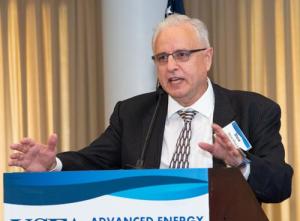Characterizing the Commissioners Now Serving
Steve Mitnick is President of Lines Up, Inc., Editor-in-Chief of Public Utilities Fortnightly, author of “Lines Down: How We Pay, Use, Value Grid Electricity Amid the Storm,” formerly an expert witness that testified before utility regulatory commissions of six states, the District of Columbia, the Federal Energy Regulatory Commission, and in Canada, and a faculty member at Georgetown University teaching undergraduate microeconomics, macroeconomics and statistics. He looks forward to each major NARUC meeting no matter the weather.
If it's Thomas Edison's Birthday, which is the eleventh of February as you all know, then the NARUC Winter Policy Summit must be taking place in Washington, D.C. As usual, the Washington weather was as cold, and the hearts of the hundred and sixteenth Congress in session on Capitol Hill were as cold, as the sixteen hundred-plus attending NARUC's winter meeting were warm and the meeting's sessions were hot.

Around two-thirds of the nation's state utility commissioners were in attendance. Which made me think. What are the demographic characteristics of the commissioners currently serving the public interest across the country?
NARUC actually has sixty-four full member commissions. Seven of them are a part of the federal government. Another seven of them aren't commissions of states — the District of Columbia, Guam, Puerto Rico (two different bodies) and the Virgin Islands - or aren't the principal regulators of utilities of a state — in Massachusetts and in Texas. Leaving them aside for a moment, NARUC has fifty full-member commissions, one for each state of the union.
Those fifty full-member commissions have a hundred and ninety-six commissioners. Though at any one time, a few of these important positions may be vacant. As of the recent publication of NARUC's 2020 Membership Directory, there were but two vacancies, one each in Minnesota and Nevada. So a hundred and ninety-four commissioners were serving out terms on state commissions.
Of that number, seventy-one serving commissioners were women and the remaining hundred and twenty-three were men. That means that women accounted for thirty-seven percent of the positions, and men accounted for sixty-three percent.
One of the fifty state commissions was completely "manned" by women commissioners. That was the three-woman Rhode Island Public Utilities Commission. And six of the state commissions were completely manned by men commissioners. That was the Alabama Public Service Commission, Louisiana Public Service Commission, Maine Public Utilities Commission, Mississippi Public Service Commission, Montana Public Service Commission, and the Public Service Commission of Utah.
Notably, the commissioners of four of these six all-man commissions - those in Alabama, Louisiana, Mississippi and Montana - are elected rather than appointed. There are just seven more states that elect commissioners rather than appoint them; each of them are filled with some combination of women and men commissioners.
It's interesting that the eleven states with elected commissions are tightly clustered geographically in three sections of the continental United States. Four of the elected eleven are contiguous in the deep south, on the Gulf of Mexico - Alabama, Georgia, Louisiana, and Mississippi. Another four of the elected eleven are contiguous in the upper midwest — the two Dakotas (North and South), Montana, and Nebraska. The last three of the elected eleven are contiguous in the southwest — Arizona, New Mexico, and Oklahoma. (Yes, Oklahoma really does border New Mexico. Look at the Google Maps app and check it out.) All the other thirty-nine states appoint their utility commissioners.
There are twenty-five additional commissioners at those seven other not-federal bodies that are full members of NARUC: the Public Service Commission of the District of Columbia — which most residents feel should be a state, Guam Public Utilities Commission, Massachusetts Department of Telecommunications and Cable, Puerto Rico Energy Bureau, Puerto Rico Telecommunications Regulatory Board, Railroad Commission of Texas, and Virgin Islands Public Services Commission. Incidentally, eight of these twenty-five commissioners are women, which is thirty-two percent.
Of the federal bodies that are full members of NARUC, the actions of two of them in particular are of considerable importance to state regulators. Of course I mean the Federal Energy Regulatory Commission and the Federal Communications Commission. Each has five commissioners, theoretically. Why do I say theoretically? Because FERC has had multiple vacancies in recent years even to the point, sometimes, of not being able to present a sufficient number of commissioners for a quorum.
Two of the fifty states have seven commissioners each. Both in the Carolinas, in the North and the South. Twenty of the fifty states have five commissioners each. They're tightly clustered in a few sections of the union. Especially in the mid-Atlantic and the Great Lakes region. Delaware, Illinois, Indiana, Maryland, Minnesota, New Jersey, New York, Ohio, and Pennsylvania have five commissioners each. These nine states account for almost half of the five-commissioner bodies.
And finally there are the three-commissioner bodies, the most common structure, which is the rule in twenty-eight of the states of the union. Three-commissioner bodies are in all the six states of New England, and in all the many states of the south and west of the continental United States except Arizona, California, Florida, Georgia, Louisiana, Montana, New Mexico, and Tennessee.
The plurality of the states have a public service commission; twenty-one of them. That's the favorite name for a state body that regulates utilities. In second place is public utilities commission; or in a few states, it's public utility commission. There's seventeen of them. What about the remaining dozen states? Four have corporation commissions, the states of Arizona, Kansas, Oklahoma, and Virginia. The other eight states have a variety of names such as commerce commission, utility regulatory commission, utilities board, board of public utilities, and department of public utilities.
Whatever their name, the state commissioners are a dedicated bunch, as is certainly the case of the thousands of commission staff. Dedicated that is, to the public interest, whenever they're within their states and whenever they're elsewhere, including in the arctic climes of Washington D.C. in mid-February.


